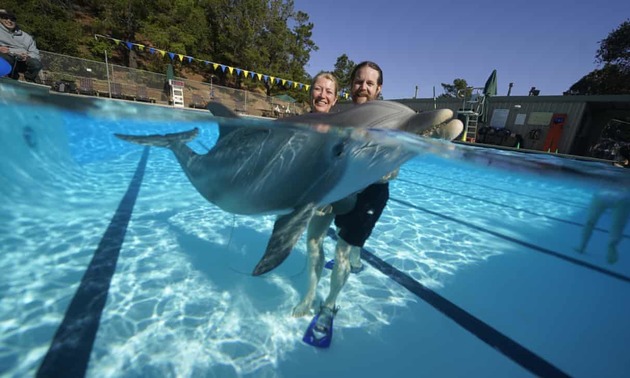Robot dolphins: the cruelty-free £20m 'animal' you can't tell from the real thing. Creators say robot dolphins provide an alternative to keeping cetaceans in captivity and could be rolled out in Chinese aquariums. They can respond to questions, swim happily in shopping mall display tanks, and withstand close contact that would usually be harmful to real animals – without any ethical problems, The Guardian writes in the article Robot dolphins: the cruelty-free £20m 'animal' you can't tell from the real thing.
Entrepreneurs in New Zealand are working with American creators of some of Hollywood’s most famous creatures to develop animatronic dolphins that look almost identical to their living counterparts. A robotic dolphin that can nod an answer to a child – thanks to the human controlling it by remote – might sound unappealing or disconcerting. But as marine parks around the world face increasing pressure to abandon exhibitions featuring real whales and dolphins, the creatures provide an appealing alternative, their creators say. “The marine park industry has had falling revenues for over a decade due to ethical concerns and the cost of live animals, yet the public hunger to learn about and experience these animals is still as strong as ever,” said Roger Holzberg, a California-based designer of the life-size robot bottlenose dolphins, and a former creative director at the Walt Disney Company. Holzberg is working alongside Walt Conti, responsible for some of cinema’s best-known sea creatures – including Free Willy and Flipper – to build the animals. “We believe that it’s time to reimagine this industry and that this approach can be more humane, and more profitable at the same time,” Holzberg added.
But with a price tag of about NZ$40m (£20.8m) per dolphin, the biggest obstacle for the creators of the animatronic creatures is proving to potential clients that the robotic sea creatures will work out to be cheaper in the long run than the real thing. Li Wang, a business developer for Edge Innovation, the New Zealand-based company making the case for the robots, said they do cost four times more than normal dolphins but would last longer. “We have to persuade them that it is a profitable business, even more profitable than live animals,” he said, adding that the robots did not require the same expensive upkeep or carefully calibrated water temperature as real dolphins. Bottlenose dolphins, on average, live for less than 20 years in captivity, but 30-50 years in the wild.
Before the Covid-19 pandemic stalled construction, at least 30 aquariums were being built in China, Li Wang said, and at least one large Chinese corporation had committed to replacing real dolphins with robots. Mike Wang, a vice president at Red Star Macalline Group – a company with a portfolio including furniture retailers and shopping malls – said it had sponsored the first phase of the dolphins’ development, and was considering the establishment of a “lab” for their expansion in China.The company would “adopt robotic dolphins and other [animals] in our new aquarium projects” and was eager to be part of the creatures’ distribution throughout the country, he said in a statement.
The robotic creatures were born out of their New Zealand creators’ unease with endorsing the real things, said Melanie Langlotz, one of the entrepreneurs behind the project – who has a background in augmented reality games. Langlotz had been commissioned to develop a digital component for the aquariums, but some of the companies she had assembled to participate were unwilling to be involved in a plan that would eventually supply live animals to captivity, she said. “It became clear that any large aquarium in China, in order to compete with any other aquarium, would need to have all the big animals on display, such as beluga whales, dolphins and sharks,” she said. “The bigger, the better.”
Debates “got more and more heated” among her New Zealand-based suppliers about the use of captive animals, she said. Finally, the group decided to pitch animatronic animals instead of live ones, inspired by New York’s National Geographic exhibition, which deploys 3D and digital technology. The prototype for the dolphin, Langlotz said, weighs more than 270kg and is indiscernible from the real thing – the condition Red Star Macalline stipulated for proceeding with the project. A test audience had been unable to guess the dolphin was not real, she added.
Animal rights advocates also welcomed the change. Elisa Allen – the UK director for People for the Ethical Treatment of Animals – said in a statement she hoped robotic dolphins “will replace real ones in marine parks worldwide”. In nature, dolphins swim “up to 40 miles a day and live in tight-knit family groups”, she said, but in captivity animals were confined to concrete pools filled with “chemically treated” water and forced to interact with strangers. “In 2020, cutting-edge technology allows us to experience nature without harming it,” Allen said. Li Wang, the business developer, did not believe people would mind that the robots were not genuine. “For people in New Zealand, for me, I liken authentic to natural,” he said. “But if we think about the younger generation, they spend far more time than us playing electronic games online. We actually need to ask ourselves what is real and what is fake.”






